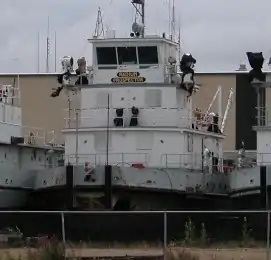
The Radium Prospector was a tugboat operated by the Northern Transportation Company's "Radium Line", on the tributaries of the Mackenzie River in Canada.[1][2] She was launched in 1956.[3] Many of her sister ships also included "Radium" in their name, hence the appellation "Radium line".
The Radium Prospector was launched in 1956.[4] In 2005 the Atomic Energy Canada published a stody on the toxic legacy of the mining of radioactive ore at Port Radium. It said that the Radium Prospector and all other surviving vessels, with the exception of the Radium Gilbert, were uncontaminated. In 2005 she was stored in Tuktoyaktuk.
The Radium Prospector helped ship the materials used to construct the remote radar stations on the Distant Early Warning Line.[5]
In his memoirs Mike Krutko described the Radium Prospector losing all the cargo on all the barges she was pushing due to a dangerous storm on Great Slave Lake.[6]
References
- ↑
Bernard Garnet McIntyre (1993). Uranium City: the last boom town. Driftwood Publishing. p. 147. ISBN 9780969713401. Retrieved 2012-12-03.
It took the combined efforts of four tugs, The Radium Prospector, Radium Miner, Radium Queen and Radium Trader to break the sunken ship loose from the muddy bottom of the lake. It was the second week of October before her bows was finally raised to within two feet of the surface.
- ↑
Geographic School Bulletins. University of California. 1965. p. 23. Retrieved 2012-12-03.
Robust river tugs like the Radium Prospector (right) steamed past me nearly every day pushing barges up and down the Mackenzie. These shallow-draft boats carry supplies during the short ice- free seasons between mid-July and the end of
- ↑
Peter van Wyck (2010). Highway of the Atom. McGill-Queen's Press. ISBN 9780773581401. Retrieved 2012-12-03.
By 1936 Eldorado had purchased Northern Transportation, and successive boats were commissioned to service sections of the Highway: the Radium King (1937), the Radium Queen (1937), the Radium Lad (1937), the Radium Gilbert (1946), Radium Charles (1947), Radium Yellowknife (1948), Radium Franklin (1951), Radium Dew (1955), Radium Miner (1956), Radium Prospector (1956), and Radium Trader (1956).
- ↑
"Status Report for the Historic Northern Transportation Route redacted colour" (PDF). Atomic Energy of Canada. December 2005. p. 86. Retrieved 2018-01-13.
Ships were used along the NTR to move barges loaded with uranium ore and concentrates (among other materials and supplies). Some vessels also transported cargo on board. Fifteen Radium Series vessels used along the NTR were identified in SENES (1994). Three were ddetermined to have been scrapped, and the disposition of one, the Radium Cruiser, was unknown. Radiological investigations were conducted on the other eleven vessels. Only one, the Radium Gilbert, showed any evidence of contamination.
- ↑ "Intrepid Tugs Man Arctic Lifeline: Canada's Seaway to the North". National Film Board of Canada. 1960-11-27. Retrieved 2020-08-20.
- ↑
Mike Krutko (2004). Mike Krutko's Amazing Adventures. Trafford Publishing. p. 164. ISBN 9781412018685. Retrieved 2012-12-03.
Meanwhile, Northern Transportation Company's Radium Prospector was pushing barges loaded to capacity with tractors and other heavy equipment. While they were on Great Slave Lake, a storm came up and all the cargo was lost.